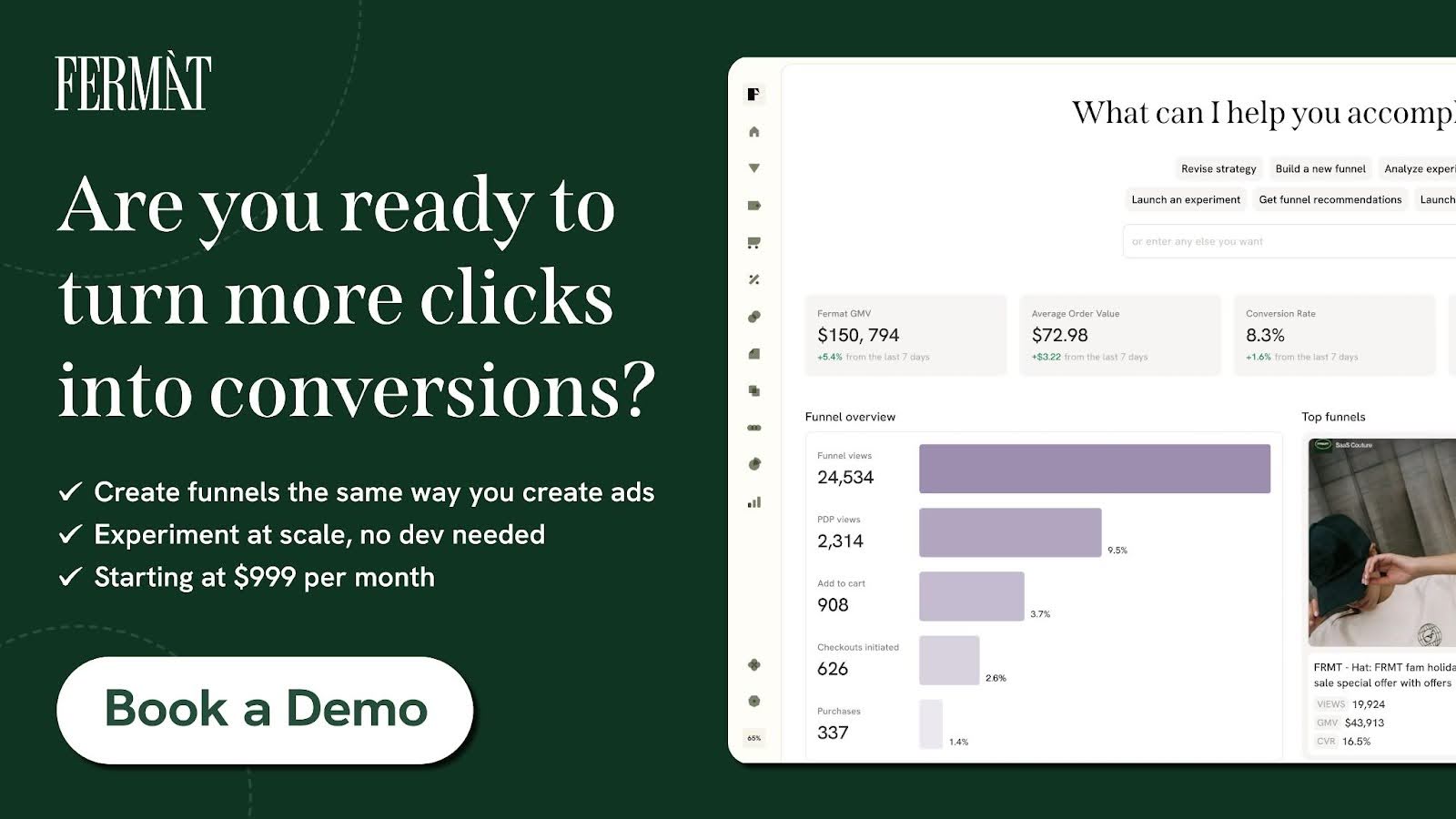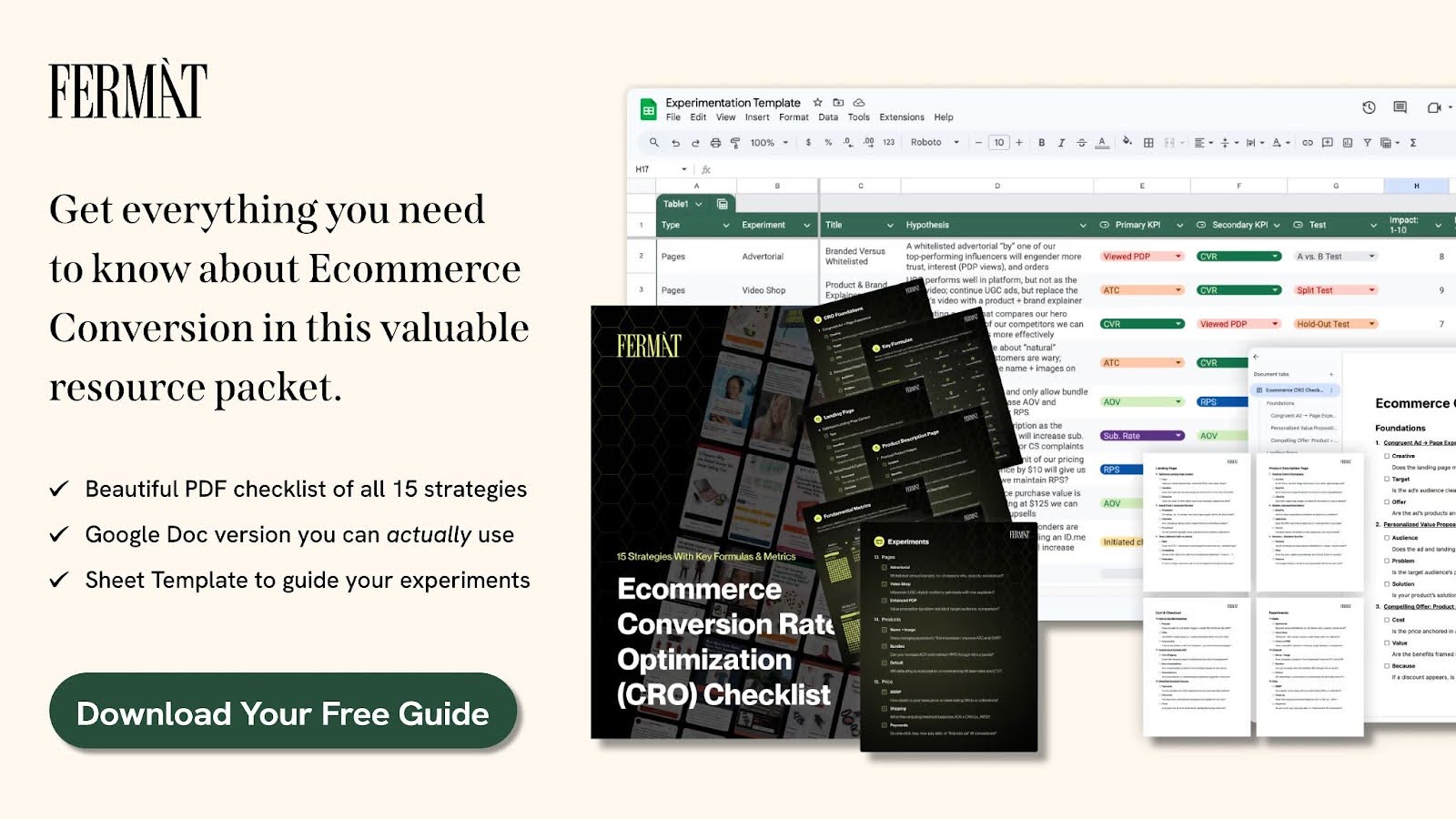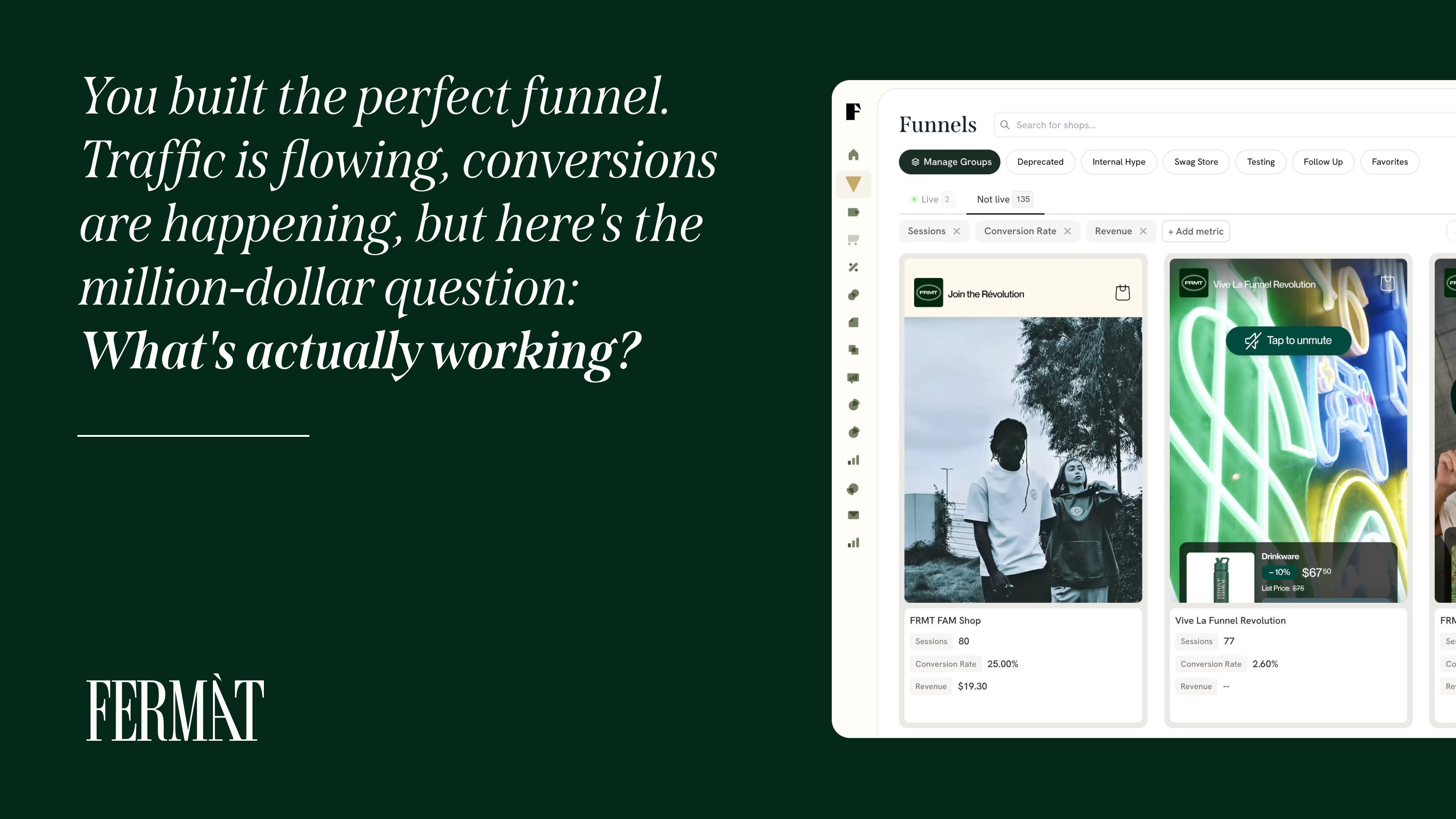
What Is A Splash Page? When And Why To Use One Effectively
Explore what a splash page is, when to use one, and why it works. See examples and discover how FERMÀT helps create impactful, data-driven entry points.
Key Takeaways:
- Understand the Unique Role: Splash pages act as focused, pre-entry screens that deliver key messages before users engage with your main site content.
- Strategic Use Only: They work best for promotions, compliance, and user segmentation — but should be used sparingly and smartly.
- FERMÀT Advantage: With tools like A/B testing and journey management, FERMÀT empowers brands to build, personalize, and optimize splash pages with measurable results.
At FERMÀT, we’re powering the next generation of commerce. Our platform enables brands to create high-performing, shoppable experiences directly within content—without sacrificing site speed, design control, or testing agility. We help turn every piece of content into a revenue-driving opportunity, and splash pages are one of the many entry points where that journey can begin.
While often overlooked or misunderstood, splash pages are a powerful web tool that can shape the user’s first impression, deliver time-sensitive messaging, and segment audiences effectively. They serve as an intentional moment of pause—a branded handshake before the rest of the experience unfolds. Done well, a splash page sets the tone for everything that follows, making it one of the most strategic elements in your digital toolkit.
In this piece, we’ll break down what a splash page is, when to use one, why they’re effective, and how FERMÀT can help you create one that converts.
What Is A Splash Page?
A splash page is a type of introductory screen that visitors see before reaching the main content of a website. Think of it as a digital welcome mat — it doesn’t act as a full homepage or a standalone shopify landing page, but rather serves a specific, often short-term, purpose.
Unlike traditional web pages designed for navigation or conversion, a splash page is usually focused on one simple message or action. It might ask users to:
- Choose a language or region
- Confirm their age (e.g., for alcohol or tobacco sites)
- View a promotional offer or event
- Read an announcement or company update
These pages are often used by brands to make a bold first impression, set the tone, or capture attention before the user sees the full site.
While they can contain a call to action, splash pages are not meant to be sales funnels. Instead, they act as a filter or a gate to the rest of your content. Their job is to direct traffic intelligently, and possibly personalize the user's entry into the broader site experience.

Splash Page Vs. Landing Page: What's The Difference?
Although they’re sometimes confused, a splash page and a landing page serve very different functions on a website. Understanding the distinction can help you use each one more strategically.
Purpose And Intent
- Splash Page: Designed to interrupt the flow — intentionally. It appears before the homepage or main content, usually offering a brief message, alert, or selection.
- Landing Page: Built to convert. Whether it’s driving sign-ups, purchases, or downloads, every element is optimized for performance. Often used in ab testing and landing page split testing to improve effectiveness.
Placement In The User Journey
- Splash Page: Typically the very first page a user sees.
- Landing Page: Often accessed via ads, emails, or social media campaigns. It’s a destination for specific offers or actions.
Design Characteristics
- Splash pages usually have minimal navigation and a single, clear function (e.g., “Enter Site,” “Choose Region”).
- Landing pages are content-rich and follow proven how to create a landing page best practices to drive conversions.
When Should You Use A Splash Page?
A splash page isn't something you add to every site by default — it's a strategic tool. When used at the right time and for the right reasons, it can enhance both user experience and brand communication.
To Make A Bold First Impression
Use a splash page when you want to set a specific tone, promote a high-impact visual, or make a branding statement. This is especially common in fashion, luxury, or creative industries where aesthetics matter.
To Promote Time-Sensitive Content
If you're launching a campaign, sale, product release, or event, a splash page can be a great way to grab attention immediately, even before the user reaches your homepage.
To Provide User Segmentation Options
For global brands, splash pages can be used to let users choose a country, region, or language, personalizing their experience right from the start. This helps with targeted customer journey management.
To Display Legal Or Age-Restricted Notices
Industries like alcohol, cannabis, or gambling often require age verification before users can access content. A splash page is the ideal place to fulfill this legal requirement without interrupting the rest of the experience.
Why Splash Pages Can Be Effective
When used correctly, splash pages offer several strategic benefits, particularly when aligned with your marketing goals or brand positioning. Here's why they work:
They Capture Undivided Attention
A splash page removes all distractions. With no navigation menus or links to pull the visitor away, it delivers a single, focused message — whether it's a promo, update, or alert. This undivided attention can drive better engagement with high-priority content.
They Set Expectations Early
By presenting key information upfront — like language preferences, shipping limitations, or age restrictions — splash pages prepare the user for a smoother experience. This can reduce bounce rates and guide users more effectively through your site.
They Reinforce Branding
A well-designed splash page offers a creative canvas to show off your brand's personality. Bold visuals, animations, or unique messaging can create a memorable first touchpoint that differentiates you from competitors.
They Help Funnel Users Efficiently
Especially when combined with tools like customer journey management, splash pages can direct different audiences to the most relevant content. This makes your site feel more tailored and improves overall usability.
Best Practices For Splash Page Design
Creating an effective splash page isn’t just about looks — it’s about purpose. A well-designed splash page delivers your message quickly and drives users forward, not away. Here are some key design principles to follow:
Keep It Simple And Focused
Limit your splash page to one primary action or message. Whether it’s choosing a language, confirming age, or announcing a product drop, avoid clutter or unnecessary elements that might confuse or frustrate users.
Design With Mobile In Mind
Many users will encounter your splash page on a smartphone. Make sure it’s responsive, loads fast, and that any interactive elements (like buttons or forms) are easily clickable on smaller screens.
Use Strong Visuals
High-quality imagery, video backgrounds, or animations can leave a lasting impression. Just ensure they don’t overwhelm the user or slow down the page load time — performance still matters.

Include A Clear Call To Action
Even if your splash page isn’t meant to convert, it should still guide the user. Use a well-placed call to action like “Enter Site,” “Choose Region,” or “Continue” to move users forward naturally.
Don’t Forget Accessibility And Compliance
Ensure your splash page meets accessibility standards (like alt text and color contrast) and complies with relevant privacy or age-related regulations if needed. This protects both your users and your brand.
Real-World Splash Page Examples
To better understand the power of splash pages, let’s look at a few real-world examples and how they’re used across different industries.
Nike – Product Launch Spotlight
Nike often uses splash pages during major product drops, such as limited-edition sneakers. These pages feature high-impact visuals and minimal text, driving hype and anticipation before users even reach the shopping area.
Absolut Vodka – Age Verification
As a brand in the alcohol industry, Absolut uses a simple splash page that requires users to enter their birth date before accessing the full site. It’s legally required, but also fits seamlessly with the brand’s sleek visual identity.
Apple – Event Announcements
Apple sometimes implements splash-style pages to showcase new event announcements or product reveal countdowns. The focus is on anticipation and user engagement, not immediate conversion — a perfect fit for the splash page format.
Fashion Brands – Visual Statements
Luxury and streetwear brands often use splash pages as a canvas for branding, showcasing cinematic video intros or full-screen editorial imagery that reflects their season's aesthetic before users dive into the shopping experience.
Nonprofits And Causes – Donation Campaigns
Organizations like WWF or charity coalitions use splash pages during emergency appeals or seasonal drives. These pages clearly state the urgency and include a single, focused call to action, such as “Donate Now.”
How FERMÀT Can Help You Create Impactful Splash Pages
If you’re looking to implement splash pages that not only look good but also enhance your marketing strategy, FERMÀT offers the perfect toolkit.
Rapid Testing And Optimization
With FERMÀT, you can run real-time ab testing and landing page split testing to determine which splash page designs or messaging yield the best results. Test variations based on audience segments, visuals, or CTAs with ease.
Built For Shopify And Beyond
FERMÀT's no-code platform works seamlessly with your existing eCommerce infrastructure. Whether you're optimizing a shopify landing page or creating a standalone splash experience, setup is simple and integration is smooth.
Advanced Customer Journey Control
Through FERMÀT’s intuitive interface, you can orchestrate detailed customer journey management, ensuring your splash pages appear at the right time, to the right audience, and drive traffic where it matters most.
Intelligent Content Personalization
FERMÀT allows you to dynamically customize splash content based on device type, referral source, or previous user behavior. This ensures every visitor experiences a tailored and relevant first interaction.

Final Thoughts
A splash page is more than a design element — it’s a strategic gateway to your website. When used thoughtfully, it can deliver key messages, enhance branding, and guide visitors toward a smoother, more intentional journey.
Whether you're aiming to announce a new campaign, meet legal requirements, or simply create a memorable entry point, splash pages offer a focused and creative way to do it. Just remember to keep the experience user-friendly, mobile-optimized, and aligned with your brand’s goals.
With tools like FERMÀT, you don’t have to guess what works. You can build, test, and refine splash pages that truly resonate with your audience, helping you turn that very first impression into a lasting connection.
Read also:
- 10 Conversion Rate Optimization Best Practices You Should Be Using in 2025
- 25 Call to Action Examples That Actually Get Clicks
- Mastering Customer Journey Management: From First Click to Loyal Advocate
Frequently Asked Questions About Splash Pages
What is the primary purpose of a splash page?
A splash page's primary role is to deliver a message or decision point before a user accesses the main site. This could include language selection, promotional content, or legal disclaimers, offering a temporary but purposeful layer between a visitor and the homepage.
Are splash pages bad for SEO?
They can be, if not properly configured. Since splash pages often have little content and limited navigation, search engines may see them as low-value. Using meta tags to prevent indexing or allowing bots to bypass splash pages ensures SEO is not negatively impacted.
Can splash pages be used on mobile websites?
Yes, but they should be optimized for speed and usability. On mobile, splash pages need to load quickly and be easy to interact with — otherwise, users might bounce before reaching your actual content.
Do splash pages work well for eCommerce sites?
Absolutely — when used tactically. eCommerce brands use splash pages to highlight flash sales, new collections, or age-verification requirements. The key is to keep them fast, visually appealing, and easy to dismiss or continue from.
How is a splash page different from a pop-up?
A splash page is a standalone screen that appears before the site loads, whereas a pop-up is an overlay that appears after the user is already on the site. Splash pages are more immersive; pop-ups are more action-oriented.
Can I A/B test splash pages?
Yes — and you should. Using ab testing, you can measure the performance of different splash designs or messages to find out what resonates best with users without compromising experience.
How long should a splash page stay live?
Splash pages should be temporary or tied to a specific campaign. Leaving one up too long can irritate returning users or make your site feel stale. Consider setting them to auto-disable or rotate based on campaign timelines.
Do splash pages affect bounce rates?
They can — positively or negatively. If the splash page is slow or irrelevant, users may leave. But if it delivers useful, engaging content quickly, it can actually reduce bounce rates by setting the right tone.
Are there industries where splash pages are essential?
Yes. Industries like alcohol, cannabis, tobacco, gambling, or international commerce often require splash pages for age verification or language selection, making them not just helpful but necessary.
Is there any analytics insight to gain from splash pages?
Definitely. Tracking click-throughs, dwell time, bounce rate, and CTA performance on splash pages gives you valuable insight into how engaged users are before they even see your homepage. These insights can improve your customer journey management.


